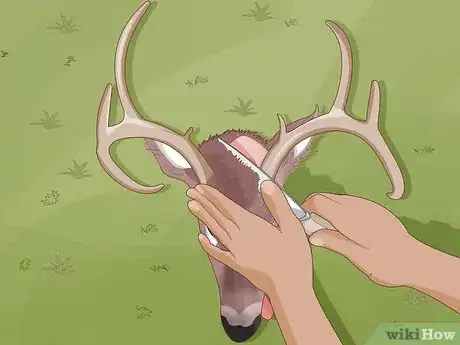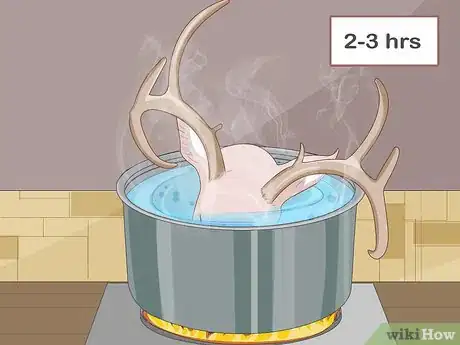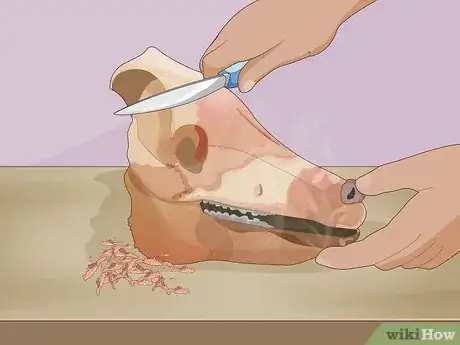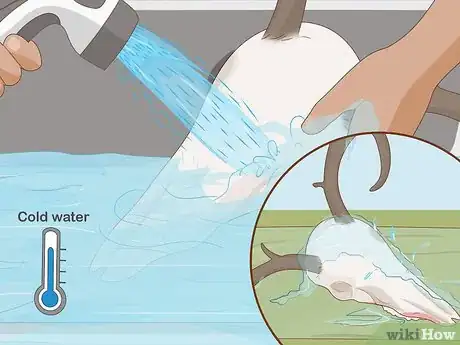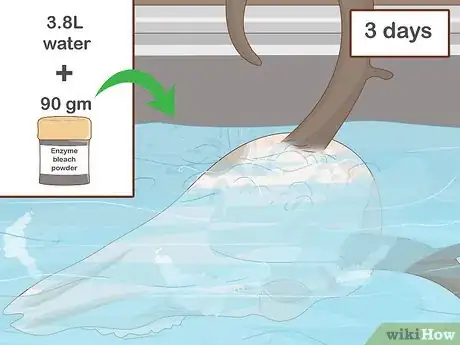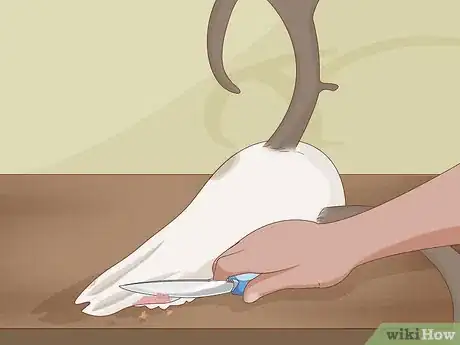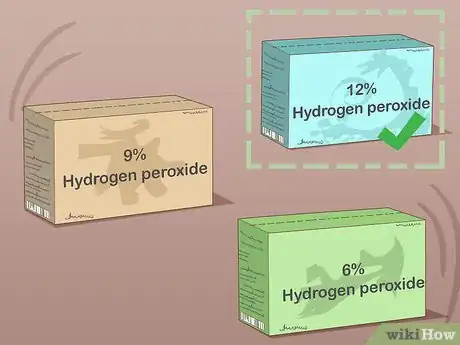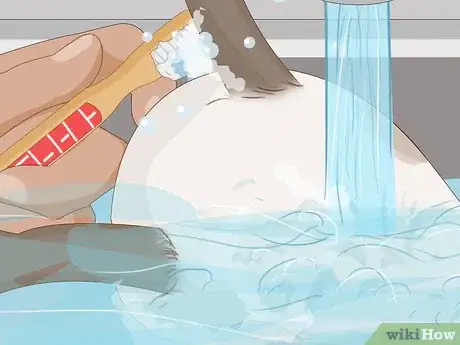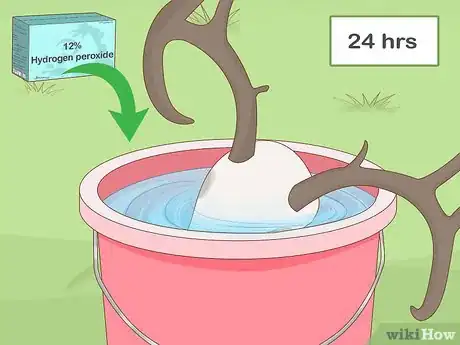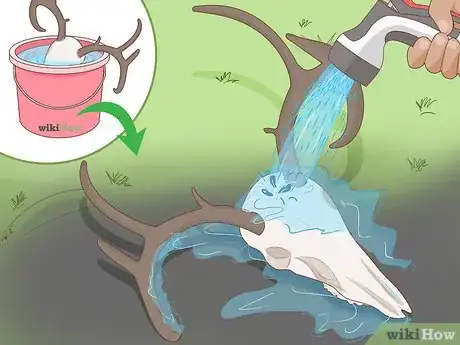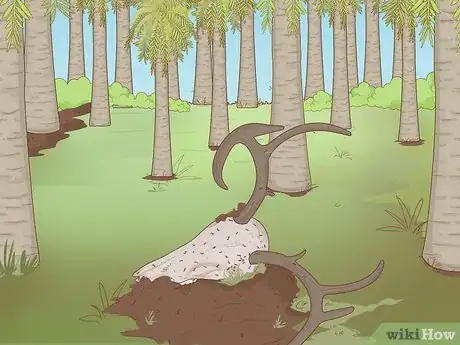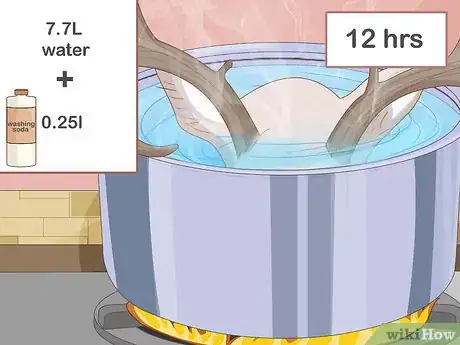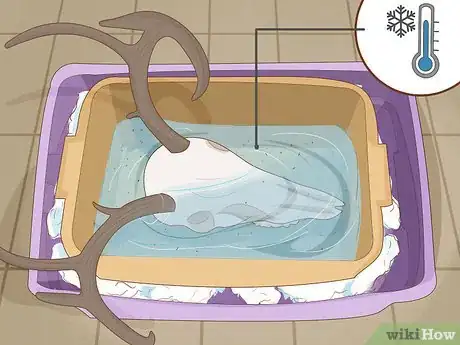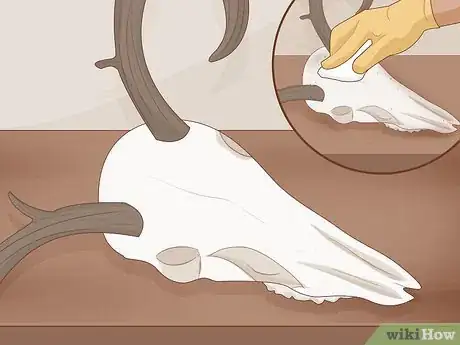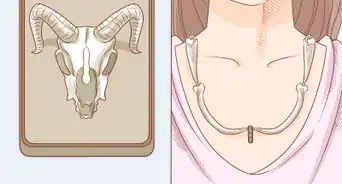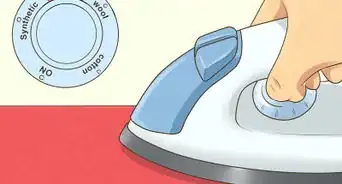This article was co-authored by wikiHow Staff. Our trained team of editors and researchers validate articles for accuracy and comprehensiveness. wikiHow's Content Management Team carefully monitors the work from our editorial staff to ensure that each article is backed by trusted research and meets our high quality standards.
There are 12 references cited in this article, which can be found at the bottom of the page.
This article has been viewed 131,588 times.
Learn more...
A deer skull can be a great ornament for the home, but there is a rigorous process of cleaning and maintaining to make sure the skull keeps a long-lasting white color. This process starts with removing the flesh, either through chemical or natural methods. You can then bleach the skull. Be sure to keep up with regular maintenance for a long-lasting aesthetic appeal.
Steps
Removing the Hide and Flesh
-
1Skin the deer skull with a sharp knife and use pliers for organ removal. Place the deer skull on the workstation and skin it with a sharp knife that you are confident using. Slice slowly, making sure you don't accidentally chip the skull underneath.
- If you have more than 1 knife, use the smaller knives for cutting off fine details and large knives for carving away the hide.
- At the end of the skinning process you should be left with the red muscle tissue beneath.[1]
- Use pliers to gently remove the eyes and tongue of the deer. Pliers are often easier than trying to slice individual organs out.
-
2Immerse the skull in hot water and simmer it for 2-3 hours. Fill a large pot (large enough to contain the skull) with hot water and keep it at a steady simmer. Then, by the antlers, lower the deer skull into the water. Leave the skull for 2-3 hours as the muscle tissue slowly loosens from the skull underneath. It is ready when the flesh separates from the skull with little effort.[2]
- If you froze your skull, this process will take about 15-30 minutes longer.
- If you over-boil the skull you risk the teeth cracking, so time the process and regularly check the skull as it simmers.
-
3Remove the flesh while the skull is still warm. Remove the skull from the simmering water and then place it on your workstation. With a small knife, carve away the flesh. It should come off in small chunks. Then, once the outer flesh has been carved away, work at removing the brain tissue from the inside of the skull.[3]
- If you wait for the skull to cool after the simmering process the removal of the flesh will be significantly more difficult.
- A small spoon or scalpel may be required to remove the brain tissue if you have difficulty with a knife.
-
4Wash out the entire skull with cold water. Once you've removed as much of the outer muscle tissue and inner brain tissue as you can, rinse out the skull with cold water. Try to remove any stubborn pieces of flesh that may have been too difficult to remove with a knife.[4]
-
5Soak the skull in an enzyme-bleach powder for 3 days. Place the skull back in a large container or pot and immerse in a cleaning solution. For every 1 gallon (3.8 L) of water added to the container, add 3/4 cup (90 grams) of enzyme-bleach powder. Leave the skull in this solution for 3 days.[5]
- Any enzyme cleaning powder from a local supermarket will work fine. This process is to try and remove the more stubborn or small pieces of flesh.
- Do not use bleach. Its chemical reaction is generally too harsh and can damage the skull.
-
6Remove the final tissue with a scalpel or knife. Rinse off the skull one more time then do a thorough check of the entirety of the skull, ensuring that all flesh has been removed. If not, the cleaning solution should have loosened the most stubborn pieces of flesh so that you can remove them with ease.[6]
- Depending on the nature of the flesh, you can either pry it off with the edge of the knife or carefully slice it off.
Bleaching the Skull with Hydrogen Peroxide
-
1Purchase 12% hydrogen peroxide. Hydrogen peroxide comes in many shapes and sizes and can be difficult to stumble across due to its potent chemical nature.[7] Chemists may sell small quantities of it over the counter, but barbers will likely sell larger bottles. Try and find at least several litres of hydrogen peroxide before beginning.
- Hydrogen Peroxide tends to come in concentrations of 12%, 9%, or 6%. Try to find the 12% version as it will work faster than the others.
- If you have a choice between a creme version and a liquid version, purchase the liquid version.
-
2Wear protective clothing before beginning. Hydrogen peroxide is a caustic chemical liquid, meaning that it can cause serious harm if it touches bare skin.[8] Always use thick plastic gloves and get into long overalls before using it.
- If you're under 18, get a responsible adult to help you with the process. Even if you're over 18, it can't hurt to have someone else to help you if things go wrong.
-
3Wash out the skull with cold water. As its been sitting on your wall more dust and dirt may have accumulated in the small cracks than you may expect. Thoroughly rinse the skull with cold water to eliminate any dirt resting within.
- If some of the dirt proves to be more stubborn, carefully scrape it away with a sharp knife or a toothbrush.
-
4Soak the skull in hydrogen peroxide for 24 hours. Once washed, place the skull in a large plastic container with a lid. Then, pour in equal amounts of hydrogen peroxide and water until the skull is covered. Secure the lid and leave it alone for at least 24 hours.
- Depending on the size of the box you may not be able to fit the antlers of the skull in. This may, in fact, be better as the chemical scouring process can make the antlers more brittle and diminish their appearance.[9] However, the liquid will be open to fresh air and won't be secured.
-
5Remove the skull and wash it again. With rubber gloves, carefully remove the skull from the plastic container and thoroughly wash it again in cold water. Otherwise, a small white powder residue may remain around the skull.
- Reuse the hydrogen peroxide mixture if you have more bones to clean. The mixture is perfectly fine to be used again for any other skull.[10] Generally, the mixture works best where it is warmer and hasn't been exposed to much air.
Cleaning the Skull with Natural Methods
-
1Expose the bones to dermestid beetles for a long-lasting natural clean. Dermestid beetles are insects in the wild that naturally feed upon the waste products on bones. Place the deer skull in a large plastic container and pour in a box of the beetles and leave them to work for a week. If you somehow missed any flesh on the skull when first cleaning it, these beetles will remove it.[11]
- A full colony of beetles (that can be purchased online or at a local taxidermist) will be able to clean a skull in 1-2 days.
- Once they have done their job gently gather them and release them into the wild once more.
- Make sure you pierce some holes in the lid for the beetles to breathe.
-
2Leave the bones out in the wilderness for a long-term solution. Nature tends to have inbuilt processes that we can only emulate. If you leave bones out in the wilderness in soil, other animals, insects, and bacteria will clean off the bones as nature intended.[12] This process is sometimes known as 'rotting'.
- This process takes a long time (2-3 months is recommended), but is inexpensive.
-
3Simmer the bones as a last resort. Although it was common practice a long time ago, boiling deer skull's is now considered to be a poor way of cleaning a skull due to it making the bone structure more likely to crack. However, it is the easiest to do.
- Place the skull in a large pot with 8.5 fluid ounces (0.25 L) of washing soda for every 260 fluid ounces (7.7 L) of water for 12 hours and regularly check the progress every hour or so.[13] You'll know it's done when the flesh is able to be carved off with little to no effort by a knife.
-
4Induce 'cold water maceration' as a safer water treatment. Cold water maceration is much like the simmering of the bones, but instead of trying to eliminate any dirt the water simply loosens any dirt that already exists like muscle fibers or tendons that were not noticed on the first clean.[14]
- Place the deer skull in a large container and fill it up with cold water and leave for 24-48 hours with the lid of the container closed if possible. Any loose dirt should become visible in the surrounding water.
-
5Use a toothbrush to eliminate stubborn dirt. If all else fails, often a toothbrush and a good deal of effort can scrub away any unwanted dirt. If you don't intend to use the toothbrush again you can dab it in a small amount of hydrogen peroxide to make the cleaning process extra effective.[15]
Community Q&A
-
QuestionCan I use flesh eating beetles to clean a skull?
 Sadie LanderCommunity AnswerYes, flesh eating beetles are a great solution. They will remove every last bit of flesh they can get. Consider having a tank of them, and set your skull in it. This an actual way of cleaning skulls, and it is quite helpful. You may want to remove the jaw though, so they can get into the crevices.
Sadie LanderCommunity AnswerYes, flesh eating beetles are a great solution. They will remove every last bit of flesh they can get. Consider having a tank of them, and set your skull in it. This an actual way of cleaning skulls, and it is quite helpful. You may want to remove the jaw though, so they can get into the crevices.
Warnings
- Be exceedingly careful with hydrogen peroxide. Always use gloves as it is a caustic chemical liquid.⧼thumbs_response⧽
- Do not clean the deer skull with bleach. This will irreparably damage the bone structure.⧼thumbs_response⧽
References
- ↑ http://www.adfg.alaska.gov/index.cfm?adfg=hunting.skull
- ↑ https://lifehacker.com/how-to-clean-animal-bones-so-that-you-may-proudly-displ-1798191351
- ↑ http://www.adfg.alaska.gov/index.cfm?adfg=hunting.skull
- ↑ http://www.hidetanning.net/SkullCleaning.html
- ↑ http://www.adfg.alaska.gov/index.cfm?adfg=hunting.skull
- ↑ http://www.skullsite.co.uk/preparation/preparation.htm
- ↑ https://www.webmd.com/drugs/2/drug-76035/hydrogen-peroxide/details
- ↑ http://www.h2o2.com/technical-library/default.aspx?pid=66&name=Safety-amp-Handling
- ↑ http://www.jakes-bones.com/p/how-to-clean-animal-bones.html
- ↑ https://www.using-hydrogen-peroxide.com/peroxide-bleaching-skulls.html
- ↑ https://blog.nationalgeographic.org/2013/01/17/flesh-eating-beetles-explained/
- ↑ http://www.jakes-bones.com/p/how-to-clean-animal-bones.html
- ↑ https://outdoorever.com/how-to-clean-a-deer-skull/
- ↑ https://extension.arizona.edu/sites/extension.arizona.edu/files/pubs/az1144.pdf
- ↑ https://empressofdirt.net/how-clean-animal-bones/
